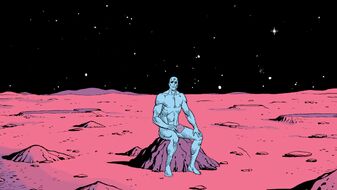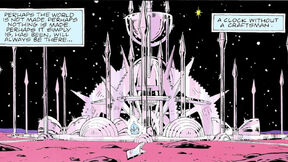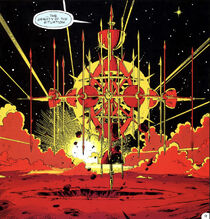
Mars is the fourth planet from the Sun in the Milky Way galaxy and the second-smallest planet in the Solar System, located 236.12 million miles away from Earth.
History[]
In October 1985, Doctor Manhattan made a startling discovery that left him tormented with the thought that he might have unintentionally caused the deaths of several of his friends due to radiation exposure. Filled with guilt and a deep need for introspection, he chose to retreat to the desolate solitude of Mars.[1]

Doctor Manhattan building his crystal clock ship
On the crimson surface of the Martian landscape, Doctor Manhattan embarked on a journey of self-reflection and contemplation. To facilitate his travels on the red planet, he constructed an awe-inspiring crystalline clockwork ship, a marvel of engineering that allowed him to traverse the Martian atmosphere with ease.[2]
Amidst the majestic Martian scenery, which included remarkable landmarks such as Olympus Mons, widely regarded as the largest volcano in the Solar System, and the awe-inspiring Valles Marineris, Doctor Manhattan pondered the arc of his existence. The vastness of the planet's features mirrored the vastness of time and space that he traversed, offering him a unique perspective on his life and the future of humanity.
During this introspective period, he returns briefly to Earth to take Laurie Juspeczyk, also known as Silk Spectre II, with him, where she'll convince him that human life is worth saving in the face of nuclear war. Recognizing her innate humanity and compassion, Laurie was chosen to accompany him on this transformative journey. They embarked on an extraordinary conversation that spanned the depths of human emotions, ethics, and the precarious state of the world.

The crystal ascends across the surface of Mars
As Laurie and Doctor Manhattan delved into the complexities of life and the looming threat of nuclear war that plagued Earth, Laurie skillfully conveyed her belief in the value of human existence and the hope for a better future. Her words struck a chord with Doctor Manhattan, reminding him of the essence of humanity and its potential for greatness.[3][4]
In an act symbolic of shedding the material and embracing the metaphysical, Doctor Manhattan chose to let the crystalline ship descend, eventually meeting its demise in the imposing Galle crater. Nestled on the eastern rim of the colossal impact basin Argyre Planitia, this act signified his renunciation of earthly possessions and his transcendence beyond the boundaries of conventional existence.
With newfound clarity and understanding, Doctor Manhattan was prepared to face his destiny and make crucial decisions that would shape the fate of both him and the world. His encounter with Laurie had rekindled his belief in the resilience and worthiness of human life.[4]
Gallery[]
Original Series[]
TV Series[]
Trivia[]
- Mars is named after the Roman god of war.
- Mars itself is approximately half the size of Earth and is coated with red dust, soil, and rocks, the result of millennia of iron oxidation on the surface. The surface itself is devoid of life. The possible colonization of Mars has been a long-standing concept and controversy in the field of space exploration.
- While life in Mars' soil or water has been a matter of research and debate for years, Doctor Manhattan is positive that (in the Watchmen universe) life does not exist at all on Mars. Manhattan contrasts the "uselessness" of life contrasting the chaos of Earth against the serene beauty of Mars.[4]
Behind the Scenes[]
- Galle, a crater on Mars named after Johann Gottfried Galle, is often known as the "happy face crater" because the illusion of a smiley face is created by a semicircular mountain range and two smaller craters within the main crater. The crater's distinctive topography evokes the smiley button worn by the Comedian. As the smiley face is a key motif in Watchmen, the crater was used as a location in the series after the coincidence was noted by Dave Gibbons. According to Gibbons, the similarity "was almost too good to be true. I worried that if we put it in, people would never believe it."
- The crater also appears in the same scene in the film adaptation.





